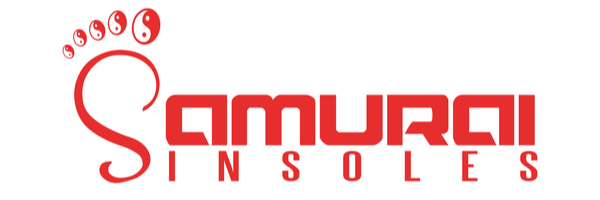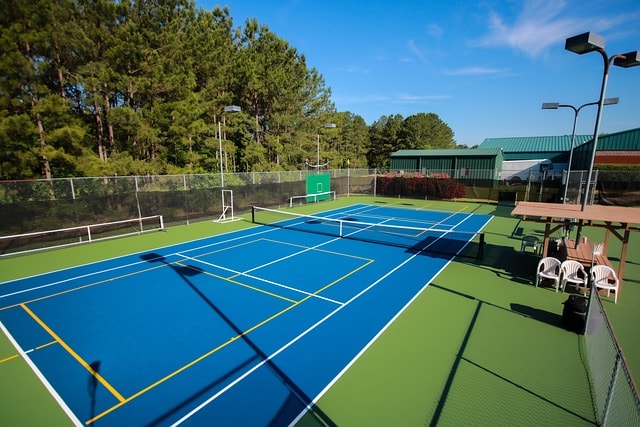If you're dealing with the daily aches and pains of fallen arches, I get it. The good news is that you can fight back. The most effective foot stretches for flat feet are all about strengthening those small, deep muscles in your feet and improving flexibility in your lower legs. Simple moves like towel curls and calf stretches can be incredibly powerful, offering a non-invasive way to build a stronger foundation and find real, lasting relief.
Why Stretching Is Your Best Tool for Flat Feet
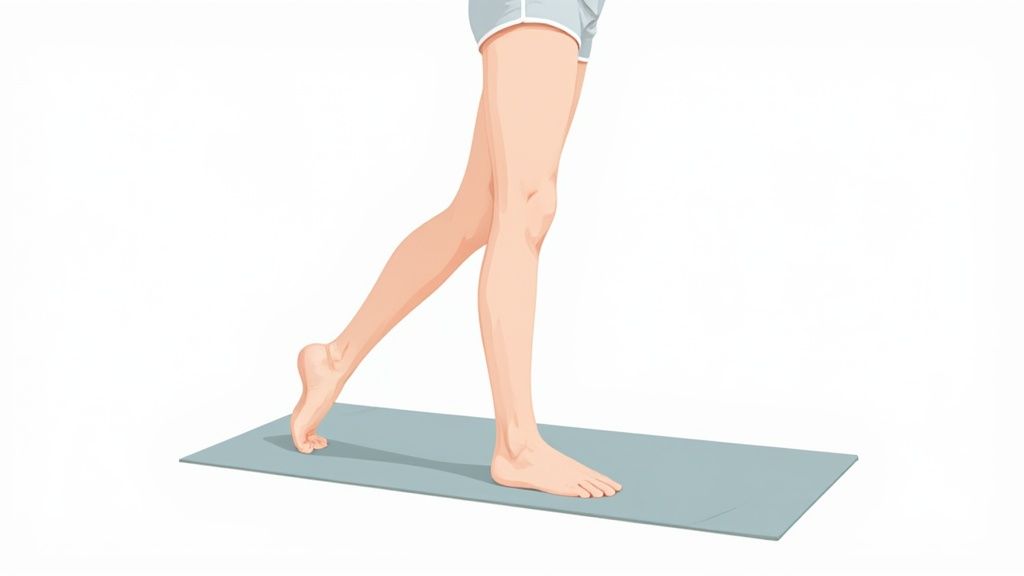
When you have flat feet, or what doctors call pes planus, you know the discomfort isn't just in your feet. It's a chain reaction. That ache can travel right up to your ankles, knees, and even your back. This happens because without a proper arch, your body's entire alignment gets thrown off, forcing other joints and muscles to pick up the slack they weren't designed for.
There are generally two kinds of flat feet you might be dealing with:
- Flexible Flat Feet: This is the most common type. You have an arch when you're sitting or not putting weight on your foot, but it vanishes the moment you stand up. The great thing about this type is that it usually responds incredibly well to targeted exercises.
- Rigid Flat Feet: With this type, the arch is gone whether you're sitting or standing. It can be a bit more complex and might be worth getting a professional opinion on.
For most people, the issue comes down to weakened muscles and tendons that are supposed to be holding that arch in place. This is exactly why a consistent stretching routine for flat feet is such a game-changer.
Building Strength from the Ground Up
Think about the muscles in your feet as the foundation of a house. If that foundation is weak, the whole structure above it becomes unstable. Stretching and strengthening exercises are like bringing in a construction crew to reinforce that crucial base.
These exercises specifically target the small intrinsic muscles inside your foot as well as the larger muscles in your lower leg, like the posterior tibial tendon, which is a main supporter of your arch. If you want to dive deeper into the mechanics, you can learn more about the symptoms and causes of flat feet in our detailed guide.
By focusing on these key areas, you're doing more than just masking the pain. You're actively rebuilding the support system your feet need to function properly, which reduces strain and helps prevent future problems.
Having flat feet is surprisingly common. Interestingly, studies show it's more prevalent in children (28.3%) than in adults (20.0%), which suggests that for many, the arch develops naturally over time. For those of us who still need a little help, a proactive approach makes all the difference.
The Direct Impact of a Stretching Routine
When you commit to a dedicated stretching routine, you get tangible benefits that go way beyond just managing pain. You're working to restore how your foot is supposed to move, improving your overall quality of life.
Here's a quick look at some common flat feet symptoms and how a consistent stretching practice directly helps.
Symptoms and How Stretching Provides Relief
| Common Symptom | How Stretching Helps |
|---|---|
| Foot Fatigue and Aches | Strengthens intrinsic muscles to better support weight and reduce strain. |
| Heel and Arch Pain | Stretches the plantar fascia and calf muscles, alleviating tension. |
| Ankle and Knee Pain | Improves alignment by building a stronger foot foundation, reducing compensation. |
| Shin Splints | Eases strain on the tibialis posterior tendon, a common cause of shin pain. |
| General Instability | Enhances proprioception (your sense of body position) for better balance. |
Ultimately, by committing to these exercises, you're directly addressing the root causes of the discomfort that comes with having flat feet. It's about taking control.
Setting Up for a Successful Stretching Session

Before you jump into any of these exercises, let’s talk about setting the stage. Think of it this way: you wouldn't start a road trip with an empty gas tank. A few minutes of prep work can make a world of difference, helping you avoid injury and get the best results from your efforts.
The most critical part? A quick warm-up. Diving into stretches with cold, stiff muscles is practically asking for a strain or pull. All you need is 3 to 5 minutes of light activity to get the blood flowing to your feet and lower legs. A little marching in place or a few ankle circles will do the trick.
Creating Your Stretching Space
You don't need a dedicated home gym for this. A small, clear spot on the floor is all it takes. If you’ve got a yoga mat, roll it out for some extra cushion. If not, a carpeted floor works just fine.
The one non-negotiable is having something stable nearby for balance. A wall or the back of a sturdy chair is perfect. This support lets you focus completely on the stretch itself, not on trying to stay upright.
Once you have your spot, grab a few simple items. Having everything within arm's reach means you can move smoothly from one exercise to the next without breaking your focus.
Your Go-To Gear:
- A small towel: This is your best friend for exercises like towel curls that build intrinsic foot strength.
- A tennis or lacrosse ball: Fantastic for rolling out and massaging the tight tissues on the bottom of your foot. For more intense, pinpoint pressure, a golf ball works wonders.
- A sturdy chair: You'll use this for seated stretches and as a reliable balance point for standing ones.
A good setup isn’t just about the physical space—it's about creating a mental one. When you take the time to prepare, you're signaling to your body that it's time to focus on recovery and building strength. It’s a small ritual that makes your foot stretches for flat feet that much more powerful.
Remember, these stretches are often most effective as part of a bigger picture. For many people, combining a consistent stretching routine with the right daily support is the key to lasting relief. You can learn more about how this works in our guide to insoles for flat feet. This two-pronged approach ensures your arches are cared for both during your exercises and throughout the rest of your day.
Essential Stretches to Rebuild Your Arches
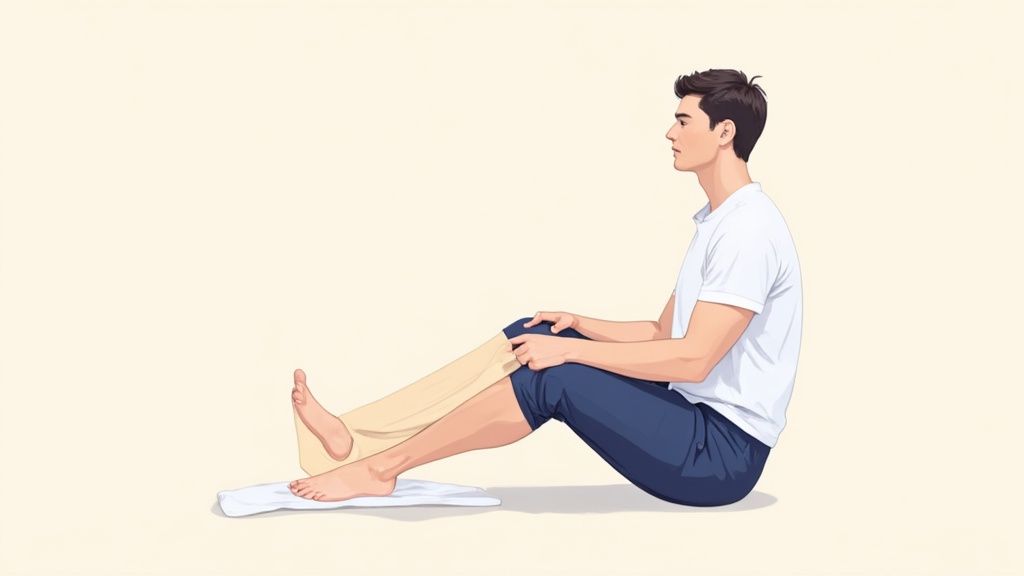
Alright, let's get to the good stuff—the actual movements that will start building you a stronger foundation. These aren’t just random stretches; they’re targeted foot stretches for flat feet that wake up and reinforce the very muscles that hold up your arches.
Think of these exercises as your daily toolkit for fighting back against foot pain and fatigue. We'll walk through how to set them up and do them right. The most important thing? Consistency. Sticking with it for even 5 to 10 minutes a day can make a world of difference in your strength and comfort over time.
Towel Curls for Intrinsic Strength
One of the best starting points is the simple towel curl. It’s fantastic for zeroing in on the small, deep muscles inside your feet—the intrinsic muscles. When they're weak, your arch sags. This exercise is like sending them to the gym.
First, find a chair and sit down with your bare feet flat on the floor. Lay a small hand towel out in front of you.
Now, keeping your heel firmly on the ground, use only your toes to scrunch the towel and pull it toward you. Focus on a slow, deliberate curling motion. Once you've gathered the entire towel, push it back out and start again.
Recommended Routine:
- Sets: Shoot for 2-3 sets for each foot.
- Reps: Do 10-15 full curls (pulling the towel all the way in) per set.
- Pro Tip: Once this feels easy, place a small book or a can on the far end of the towel. The extra weight adds a new challenge.
This movement directly targets the muscle weakness that causes arches to fall. You should feel a distinct tightening along the bottom of your foot. It's subtle but incredibly powerful for rebuilding support from the ground up.
The Short Foot Exercise
The short foot exercise is more of a mental challenge than a big movement, but it's incredibly effective. It's all about an isometric contraction—squeezing the muscle without much visible motion. This exercise basically teaches your brain how to consciously engage and lift your arch on command.
Sit with your foot flat on the floor. Without curling your toes or lifting your heel, try to shorten your foot by pulling the ball of your foot back toward your heel. The goal is to create a "dome" or raise your arch as high as you can. It’s a very small, precise action.
Hold that squeeze for 5-8 seconds, then relax.
This exercise is pure muscle activation. Don't get discouraged if you barely feel it at first. It takes practice to find and isolate these muscles. Stick with it, and you'll feel that arch engage more and more strongly.
This is a fantastic exercise for improving what's called neuromuscular control, essentially waking up the connection between your brain and the muscles supporting your foot.
Heel Raises for Arch and Ankle Support
Heel raises are a classic for a reason. They don't just work your calf muscles; they also strengthen the posterior tibial tendon. This crucial tendon runs down the inside of your ankle and is one of the main supporters of your arch. Strong calves create better stability for your entire lower leg and foot.
Stand with your feet about hip-width apart, holding onto a chair or wall for a bit of balance.
Slowly rise onto the balls of your feet, lifting your heels as high as you comfortably can. Pause for a second at the top, feeling the work in your calves and the lift through your arches. Then, slowly and with full control, lower your heels back to the floor.
This is especially important because flexible flatfoot is surprisingly common, affecting around 13.6% of adults. Simple exercises like calf raises are a cornerstone of managing it effectively. A study on flatfoot prevalence and management confirms that these movements help relieve symptoms and improve how your feet function day-to-day.
Routine for Heel Raises:
- Start with 2 sets.
- Aim for 15 repetitions per set.
- The key is the slow, controlled motion—both up and down. Don't just let your heels drop!
By weaving these essential exercises into your daily routine, you're taking direct action to rebuild your arches and dial down the discomfort of flat feet. This is how you build stronger, more resilient feet for the long haul.
Ready to move beyond the basics? Once you’ve built a solid foundation with those initial exercises, it’s time to take things up a notch. We’re going to look at the bigger picture now, moving from the small muscles inside your feet to the major support structures in your lower legs.
Your feet don’t exist in a bubble. They’re connected to everything else, forming a chain that includes your ankles, calves, and Achilles tendon. When these areas get tight—especially the calf muscles—they can pull on your heel, making overpronation and the effects of flat feet even worse. By adding some more advanced stretches into your routine, you’re doing more than just helping your arches; you’re realigning your entire lower body from the ground up.
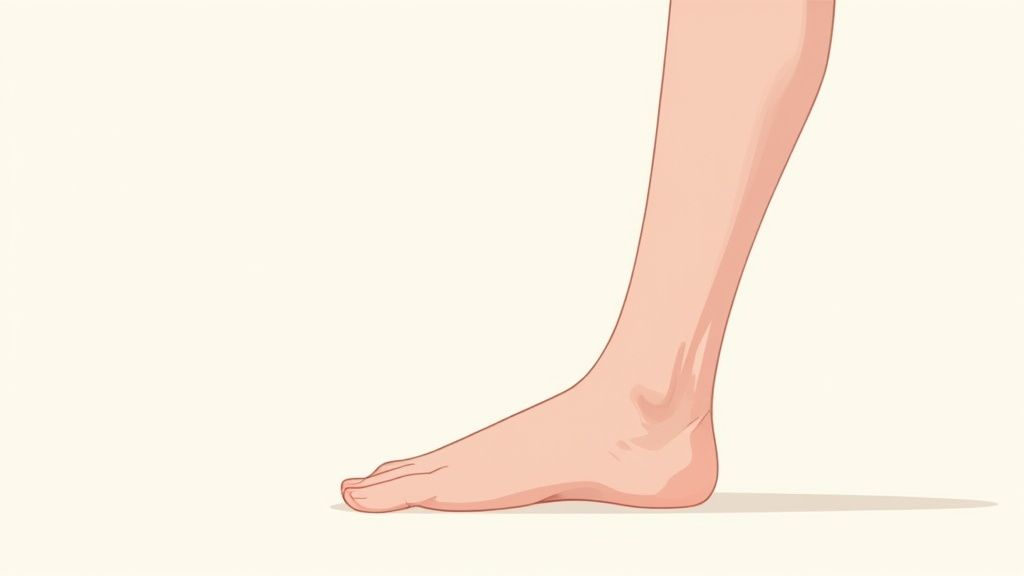
Deepening the Calf Stretch
You’ve probably done a basic calf stretch before, but let’s refine the technique to hit the two key muscles involved: the gastrocnemius (the big upper calf muscle) and the soleus (the lower one). Both are major players in how your foot functions, and releasing tension here brings incredible relief.
Getting the Gastrocnemius (Upper Calf)
- Start by facing a wall, placing your hands on it for a bit of balance.
- Step one foot straight back, making sure to keep that leg completely straight and your heel glued to the floor.
- Now, gently lean your hips forward toward the wall. You should feel a clear, strong stretch in the upper, fleshy part of your calf.
- Hold that position for 20-30 seconds. Don't bounce. Just breathe into it.
- Switch legs and repeat. I recommend doing 2-3 sets on each side to really make a difference.
This is that classic wall stretch most people know. It’s great for the big gastrocnemius muscle. But we're not done yet.
Targeting the Deeper Soleus Muscle
Often overlooked, the soleus muscle sits right underneath the gastrocnemius and runs closer to your Achilles tendon. I've found that tightness here is a hidden source of foot pain for many people.
To get at the soleus, you’ll start in the exact same wall stretch position. The only change? This time, allow a gentle bend in the knee of your back leg. Keep that heel firmly on the ground as you bend. You’ll immediately feel the stretch move lower down your calf, much closer to the ankle. That’s the sweet spot. Hold it for another 20-30 seconds.
By doing both versions—one with a straight leg and one with a bent knee—you’re ensuring the entire calf complex gets the release it needs. Trust me, this two-part approach is far more effective than just picking one.
A More Intense Plantar Fascia Stretch
Rolling your foot on a ball is fantastic for massaging the plantar fascia, but for a deep, static stretch, you can’t beat using a wall or a curb. This technique directly lengthens that tight, fibrous band of tissue running along the bottom of your foot.
Simply stand facing a wall. Place the ball of one foot up against the base of the wall so your toes are pointing upward. Keep your heel flat on the floor.
From there, lean your body gently into the wall. You’ll feel a powerful, sustained stretch all along your arch. It should feel significant, but not sharp or painful. Hold this for a solid 20-30 seconds before switching to the other foot. This is easily one of the most direct and effective foot stretches for flat feet you can do.
Common Stretching Mistakes to Avoid
Even the best stretches for flat feet won't do you much good if your form is off. To get the relief you're after and sidestep any new strains, it’s crucial to be mindful of a few common pitfalls. Let’s walk through them so you can make every single movement count.
Pushing Through Pain
This is a big one. You should feel a gentle, deep pull during a stretch—never a sharp, stabbing, or radiating pain. If you hit that kind of pain, that's your body's signal to stop, not to push harder.
The goal here is to gently lengthen your muscles and tendons. Forcing them past their limit is a surefire way to cause an injury, which sets you right back to square one.
Forgetting to Breathe
It's surprisingly easy to hold your breath when you're concentrating on a stretch. The problem is, when you do that, your muscles tense up, which is the exact opposite of what you're trying to achieve.
Instead, make your breath part of the movement. Take a slow, deep breath in before you start, and then exhale as you ease into the stretch. This simple trick tells your nervous system it's okay to relax, allowing for a much deeper and more effective release.
Rushing or Bouncing
In a hurry? Don't let it show in your stretching routine. Many people either rush through the motions or use a bouncing movement, thinking they're getting a deeper stretch. This is called ballistic stretching, and it's a risky move that can cause tiny tears in your muscle fibers.
The best way to stretch is with a static hold. Ease into the stretch until you feel that gentle tension, and hold it right there—steady and still—for a good 20-30 seconds. This gives your muscles the time they actually need to relax and lengthen safely.
Considering that flat feet can affect up to 70% of children aged 3 to 4 and stick around for 20-30% of them by age 8, building good stretching habits from the get-go is key. You can read more about the prevalence and importance of addressing flatfoot on PMC. Doing these exercises correctly is what makes them a solution, not another problem.
Ignoring Your Foot's Alignment
Finally, a subtle but incredibly important mistake is letting your foot get out of alignment during the exercises. For example, when you're doing a towel curl, it’s all too easy to let your foot roll outward or inward instead of keeping it perfectly straight.
Pay close attention to your form.
- Are your toes pointing straight ahead during that calf stretch?
- Is your heel planted firmly on the floor when you scrunch the towel?
These small details make all the difference. They ensure you're actually targeting the muscles responsible for supporting your arch. When you correct these common errors, you transform your routine from just going through the motions into a powerful, effective practice for healthier feet.
Pairing Stretches with Supportive Footwear
Stretching is a fantastic way to rebuild your foot’s internal strength, but let’s be honest—it’s only half the battle. Think of it this way: your stretching routine is the workout, and supportive footwear is the all-day protection that lets those newly strengthened muscles actually do their job without getting exhausted.
When you do these exercises for flat feet, you're essentially waking up and toning the muscles that are supposed to hold up your arches. But the second you stand up and start walking on hard, flat surfaces, those same muscles are put under immediate and constant stress. This is where getting some outside help becomes your secret weapon.
Why External Support Makes All the Difference
Good shoes and quality insoles act as a crucial bridge. They give your arches the lift they need while your internal muscles are busy getting stronger behind the scenes. Without that support, it’s all too easy for your feet to slip back into their old, painful habits of overpronation, which can wipe out the progress you’ve worked so hard for.
This teamwork between stretching and support is absolutely critical. Your stretches build the potential for strength, and your footwear provides the stable environment needed to lock it in.
When you're shopping for your next pair of everyday shoes, keep an eye out for these features:
- A Firm Heel Counter: The part of the shoe that wraps around your heel should be stiff, not flimsy. This prevents your foot from rolling inward, which is a hallmark of flat feet.
- Good Torsional Stability: Grab the shoe and give it a twist. If it twists easily in the middle like a wet towel, it lacks the midfoot support you desperately need.
- Built-in Arch Support: The shoe itself should have a supportive shape that cradles your arch, stopping it from collapsing every time you take a step.
The right footwear isn’t just about preventing pain. It actively helps your stretching routine succeed by creating a stable platform for your feet. This allows the muscles you’re strengthening to work more efficiently and with way less fatigue.
Adding Insoles for Maximum Impact
While some shoes come with decent built-in support, it’s rare to find one that can match the targeted help of a well-designed insole. Insoles are engineered specifically to provide the kind of arch support that most shoes are missing, correcting your alignment and spreading pressure more evenly across your foot.
They essentially give your feet a constant, gentle reminder of what proper alignment feels like. This continuous feedback helps reinforce the correct posture you're aiming for with your stretches. This is true even when you're just kicking back. For example, even your choice of summer shoes can have a big impact, which is why we created a guide to help you choose the best sandals for flat feet that won't sabotage your progress.
When you combine a daily stretching routine with the right external support, you create a complete, 24/7 strategy for tackling flat feet. The stretches build your internal foundation, while your shoes and insoles provide the external scaffolding needed for lasting relief and strength. It's truly the combination of these two approaches that leads to happier, healthier feet.
Are you ready to give your feet the all-day support they need to complement your stretching routine? Samurai Insoles are designed by a podiatrist to provide the perfect balance of arch support and comfort, helping you feel relief with every step. Find your perfect pair of Samurai Insoles today.
